How to revive an orchid?
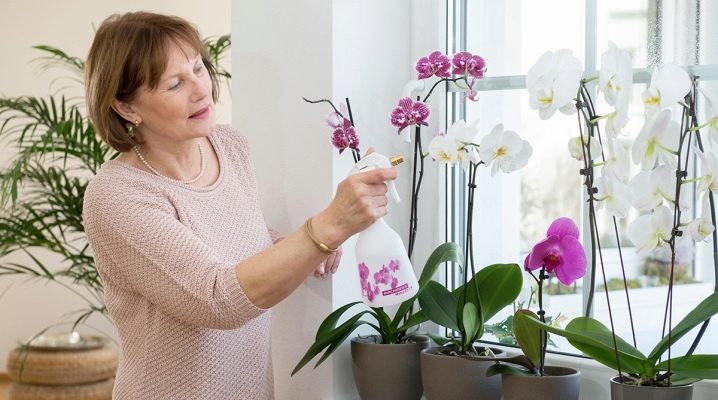
Many people really like such an original and beautiful flower like an orchid, but not everyone knows that caring for it is quite difficult. If you do not give the flower the necessary conditions for existence, then the contemplation of beauty will very soon stop, since the plant will simply die. In the event that the first signs of extinction began to appear on the orchid, you need to know how to take measures to save it.
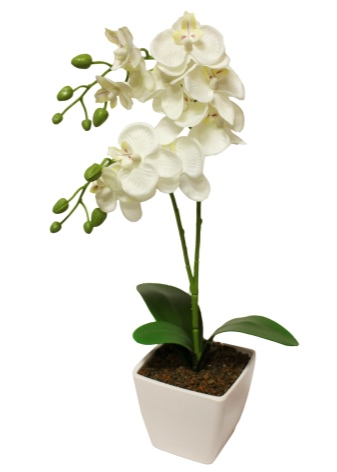
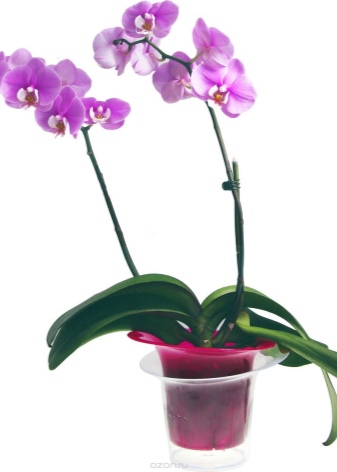
Why is the orchid dying?
The orchid is a plant that came to us from a tropical habitat, therefore, significant temperature changes, changes in the length of daylight hours become destructive for it. If in the warm season the flower feels good, even being on the street, then in the cold season inexperienced florists have obvious problems with caring for it. If you do not create the right conditions for existence, then very soon you can see how the orchid disappears before our eyes. To understand what happened and what should be done, you need to inspect the plant and pay attention to:
- foliage - in case of problems with the roots, the flower will have sluggish leaves that will rapidly turn yellow;
- escapes - if there is a yellowing process from the top to the root, then this indicates obvious problems with the health of the flower;
- no flowers for a long time - the root dies, it does not have the strength to nourish the buds and give them the opportunity to bloom;
- steady flower growth - a healthy bush grows upright and sits well in a pot with slight fluctuations, but if the arrow begins to tilt, and the orchid dangles when the pot moves, then the root system is no longer able to firmly hold the bush in the ground.
In the event that the house plant has at least one of the above signs, it is worth removing the roots from the pot, cleaning it from the soil and carefully examining it.
To understand whether the root system is alive or not, you should pay attention to the following signs:
- Colour - live roots are usually light or greenish, while rotten ones become dark, black or brown;
- elasticity - a healthy root has a dense structure, and a dead one becomes soft due to voids inside due to an active decomposition process.
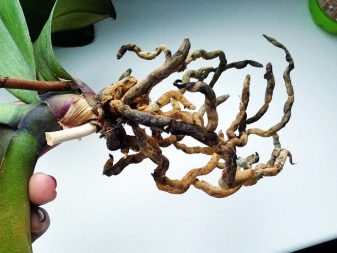

The orchid did not die until it completely dried up, in all other cases there is an opportunity to save it. Among the most common problems with orchids that are found in novice florists are:
- bush without a growth point;
- frozen top;
- the arrow broke;
- leaves wither;
- overflow of a flower;
- a branch broke off;
- the leaves are burnt in the sun;
- I came across a painted orchid.
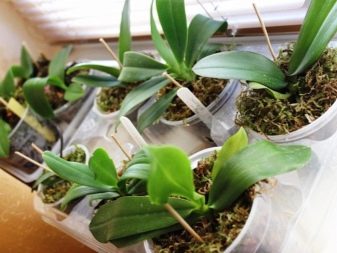
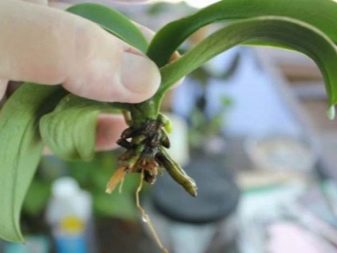
Despite the fact that the problems are quite different, they can be caused by only five factors.
- Overheating of the flower. The conditions in which the flower is located must be under control at all times. Leaving your orchid all day in an unventilated hot room or on a sunny window will overheat. Due to active heat exposure, there is an intensive consumption of moisture, which soon ends, which provokes wilting of foliage and drying of the entire flower. If it was not possible to save the orchid from such a situation, you must immediately start helping the flower by removing it for a couple of hours in a dark part of the room so that the plant will come to its senses. It is very important at this moment not to touch the bush, letting it just rest, and then add water or spray the foliage.It may take from one to two days to fully return to the previous state.
After such stress, it is important to carefully monitor the state of the environment and solar activity, so as not to allow another overheating in any case.
- Violation of watering rules. It is worth remembering that the orchid is a tropical plant and loves water, but in a normalized amount. If you constantly fill the pot, then you can only achieve rotting of the roots. To avoid this, it is worth adding water only when the soil is well dried. Another problematic situation is insufficient watering, which also has a bad effect on the plant, because the roots simply dry out. There is no clear framework for watering time, therefore it is worth relying on the appearance of the soil in the pot - as soon as it has dried well, you can add moisture.
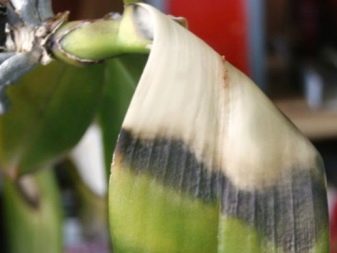
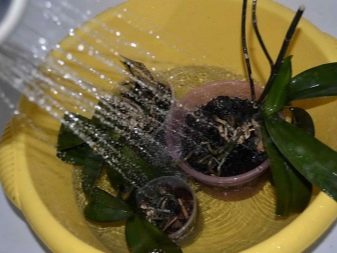
- The presence or absence of fertilizers. Any plant that grows in atypical conditions for itself must be supported with fertilizers. Excessive amounts of them will not be beneficial, as instead the root system will be poisoned and the bush will die. To understand that there is too much fertilizer, one has only to carefully evaluate the appearance of the flower. With an excess of nutrients, you can see the wilting of the plant, yellowing of the foliage, a change in the color of the roots and their decay. If you notice these signs in time, there is a chance to save the orchid by removing it from the pot, washing out the roots, removing all damaged parts and planting it in new soil.
- Decay of roots. In case of obvious changes in the ground part of the plant, it is worth checking the condition of the root system. If she is in order, then the cause should be looked for in something else, but if there are clear signs of death, then it is worth trying to stop this process and save the flower.
- The presence of parasites in the ground - most often, problems arise with an orchid when parasitic beetles, which are also called clickers, are introduced into the soil. It is they who become the main reason for the wilting of the root system, as they actively absorb it. To get rid of such a misfortune, you need to remove the flower from the old pot, eliminate the soil, wash the roots and plant it in new soil. It is important to wait a certain amount of time before applying any fertilizers, otherwise you can poison the roots of the plant, which have not yet recovered from the attack of the beetles.
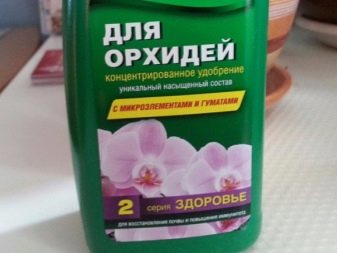
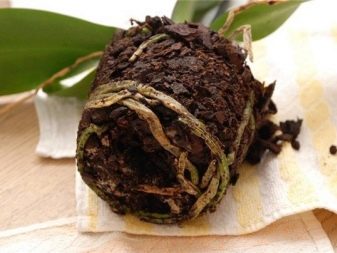
Whatever problem you have to face in the process of caring for an orchid, it is important to know that there is always a chance to save it, the main thing is to carry out all the necessary actions on time.
How to save a flower?
If the home orchid began to die quickly, then it can be saved thanks to the measures taken on time. Resuscitation at home will depend on the severity of the condition of the flower and the problem that had to be faced. In the event that the roots of the plant have rotted, it is necessary to urgently reanimate, otherwise it will not be possible to save the bush. The procedure boils down to the fact that the orchid is transplanted into a specialized greenhouse, which is bought or made by hand using a plastic bottle. For a faster recovery, you need to place the culture in expanded clay, it will also feel good in moss.
For active recovery, you need to take care of specialized lighting, which can be created thanks to a phytolamp. To leave the bush, the following activities should be carried out:
- from time to time, soak the flower in a solution from a nutrient mixture and in water;
- in the place where the leaves should grow, it is necessary to wipe the branches with a special solution to stimulate growth;
- carry out bath procedures for a flower using specialized preparations.
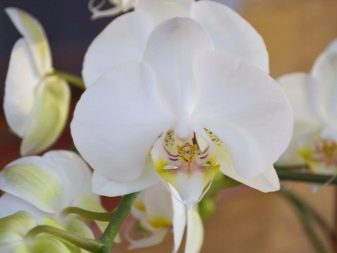
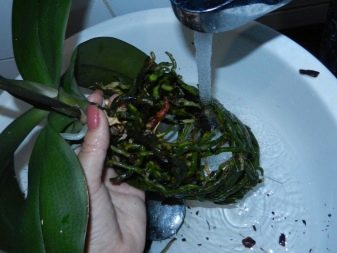
Among the most useful and fast-acting drugs that can effectively save an orchid, there are several.
- B vitamins. Thanks to them, you can restore the root system.Once a month it is necessary to leave the plant in such a solution, and once a week to wipe all its parts.
- Substances for growth regulation. Due to the presence of phytohormones in the composition, it is possible to quickly restore the structure of the roots. Every month it is necessary to soak the bush in this composition.
- Fertilizers containing potassium and phosphorus. You can use them once every two months.
- Glucose. In a healthy flower, this substance is produced independently, and in case of illness, it is necessary to help stimulate the formation of new cells, which is possible thanks to glucose.
- Microfertilizers. It is possible to accelerate the growth of roots and foliage thanks to the gland.
It can take from two months to a whole year to fully revive a flower after serious damage, so you should not give up trying to save the culture if it is still showing signs of life.
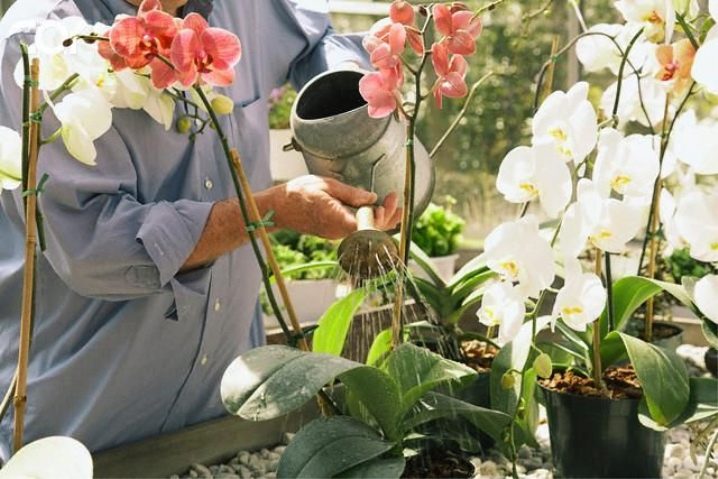
If the orchid lacks a growing point, it is necessary to remove all rotten roots and put the bush in the water. You need to cut off the spoiled roots with scissors that have been previously disinfected.
To speed up the recovery process, it is necessary to choose the most illuminated place in the room for the orchid. If everything is done correctly, then in the near future the regeneration process will begin and new roots will appear.
If all the leaves on the culture have fallen off, you must do the following:
- remove the bush from the pot, free it from the ground and assess the condition of the root system;
- do not panic at the first fall of the foliage, because this is a natural process, therefore it is important to clearly separate these two states and intervene only if there is a problem;
- it is worth paying attention to watering, the amount of water and the frequency of the procedure;
- in the case of a recent purchase of a plant, it is necessary to examine its roots for decay or damage by pests and diseases;
- if necessary, you can use a room greenhouse;
- from time to time it is better to change the soil of the orchid in order to minimize the risk of infection of the root system;
- if the flower is tall and supports are needed for it, it is important to be able to install them correctly, so as not to damage the rhizome, which may be the reason that the bush is dying.
If the orchid wilted, and none of the above problems helps, then most likely the reason for everything is damage by diseases and pests. In this case, the bush is saved by other methods.


To determine what kind of help is needed, it is worth understanding the cause of the problem.
- If the care of the plant is carried out incorrectly, then it is likely that you will have to face fungal diseases, which manifest themselves in the yellowing of the foliage and the formation of bumps on them. To save the leaves, you need to treat them with fungicides, and the heavily affected parts were completely successful.
- Another problem is associated with the appearance of bacterial stains - most often old foliage that needs to be cut is affected. If this procedure is carried out in time, then the bush will be in perfect order. The cut must be treated with charcoal and bactericidal preparations.
- When the roots dry out, they begin to die off and can no longer provide normal nutrition to the entire flower, therefore the leaves turn yellow and fall off. To save the orchid, they transplant it and change the care for it.
- The presence of a putrefactive disease - if the irrigation regime and the temperature in the room do not match, this disease can develop. The danger of the disease is that it does not manifest itself immediately, therefore you need to react immediately by transplanting the plant into a new pot, while ensuring it is quarantined for one week.
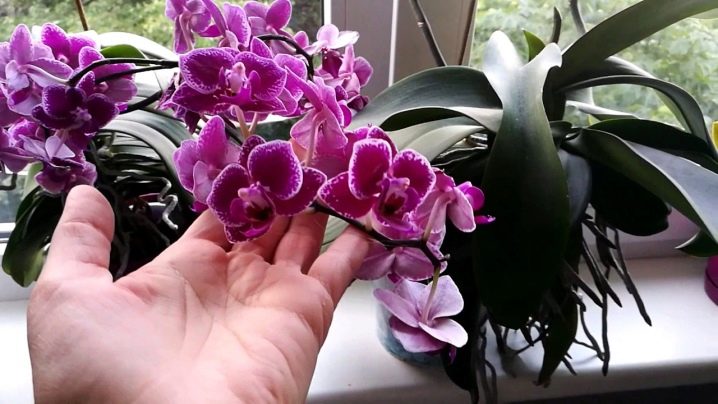
In addition to diseases, pests can also bring problems to the culture. The first sign of their defeat is the wilting of the foliage, therefore it is worth being careful with this state of the flower. Such insects are considered the most dangerous representatives for orchids.
- The scale insects are small parasites that settle on the leaves of plants and suck out all the juices from it, which is why the wilting process takes place. To get rid of the scale insects, you need to quarantine the orchid and spray it with a bactericidal preparation.
- Whiteflies look like small white insects that feed on foliage, completely destroying it, which prevents the plant from carrying out photosynthesis processes, and this leads to death. To get rid of the whitefly, it is necessary to keep the orchid in quarantine, which will make it possible to prevent the pest from spreading to other flowers. After that, bactericidal preparations and a solution of laundry soap are used.
- Worms look like small white lumps that spread to both parts of the leaf and interfere with metabolism, which leads to disruption of plant development. The resuscitation process is carried out mechanically, after which specialized drugs are already used.
- Spider mite is a pest that covers the leaves like a cobweb, which disrupts photosynthesis and helps dry the flower. You can save the orchid by treating it with soapy water and bactericidal preparations.
- Powdery mildew appears when the room is humid. A white bloom forms on the leaves, which causes the death of the entire plant.
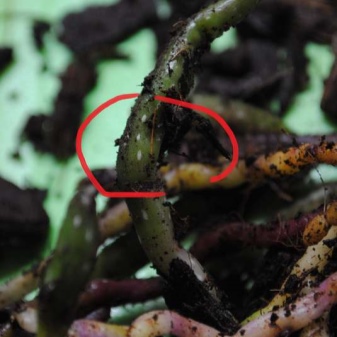
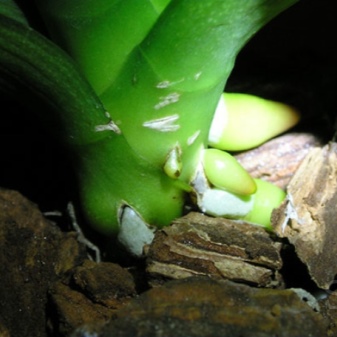
If only the purchased or donated orchid began to die, you should immediately take all possible measures to revive it. The sooner the cause of the wilting is established, the sooner it will be possible to begin the process of saving it. Having an idea of what kind of flower care should be and what conditions he likes, and which should be avoided, you can minimize the risk of damage to a home plant and admire its growth and flowering for a long time.
Follow-up care
Depending on the scale of damage to the orchid, the duration of the period of its recovery will also depend. This can take from six months to a year, so you should be patient and take care of the plant in such a way as to facilitate its recovery period as much as possible and resume all life processes. In order for the flower to develop faster, you can wipe the leaves with a solution that activates and accelerates growth. For optimal results, it is sufficient to do this 1-2 times a week.
It is better to restore the orchid in the warm season. In winter, the healing procedure takes longer. Depending on the problem that you had to face, you may need to transplant the flower into a new container. It is best to grow your orchid in a pot that is suitable for the size of the particular plant.
It is important to allow the roots to grow without constraining them. If a transplant is still needed, it is worth taking care of the correct substrate, which will be light and nutritious, which will speed up the recovery of the culture.
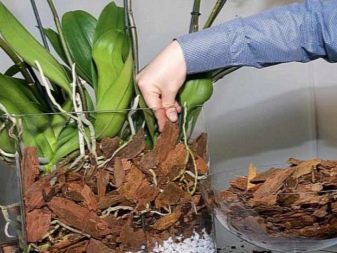

Planting in pine bark is considered the most acceptable option, since it:
- makes the soil breathable;
- is moisture-absorbing, makes it possible to remove excess moisture;
- has an antiseptic effect due to lignin;
- it contains a lot of nitrogen, ash and oxygen, wax, vegetable fats and other trace elements and mineral acids.
Having done all the measures to restore the plant, it is worth doing everything possible to prevent this from happening again. In the future, it is necessary to strictly monitor watering, light, temperature and humidity in the room.

Advice
To carry out successful resuscitation actions, you need to have the maximum amount of information, including being guided by the advice of people who have tried out certain methods in their own experience. Among the most valuable tips are the following.
- In case of root rotting from below or rotting of the entire root system, the flower should not be immediately placed in moisture in order to restore the roots.The first priority is to fight the disease or parasites that have led to the disastrous result. It is important to treat the affected area with fungicides and dry it well. In order for the orchid to receive moisture, it is necessary to place it above the water, keeping it in this position for about two weeks, after which it will be possible to germinate the roots in the water.
- If there is a rotten area on the stem or root, it must be cured, for which dryness is a prerequisite. Once you manage to cope with the problem, you need to plant a flower and spray or wipe its leaves to give them moisture. Watering at this time will be undesirable. As soon as the bush is well rooted, spraying stops. You can add water in a standardized amount.
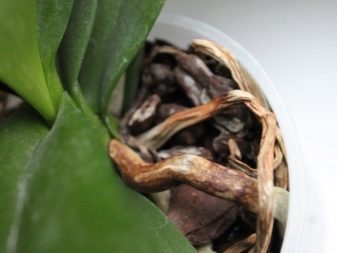
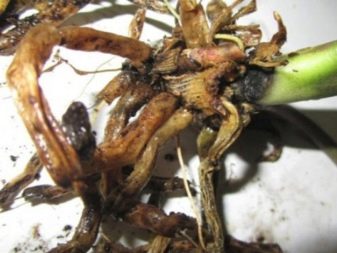
- In the absence of rot on the root or stem, you can skip the process of abstaining from water germination and immediately use the moisture to or increase the root system.
- In order for the resuscitation process to take place as quickly as possible, you need to give the orchid maximum light. In winter, fluorescent lamps are used for this, which can work 15 hours a day. The device should not emit heat so that the leaves do not overheat and dry out. In the summer, there are no problems with light, the main thing here is to protect the culture from direct sunlight.
- In the event that the lower leaf begins to turn yellow from the edge, this is normal, but if the process comes from the stem, then rot develops in it. In the first case, the leaf must be removed when it has turned yellow by more than half, in the second - at the first signs. Removal occurs by tearing off the sheet, and not cutting it off. It is important to carry out the procedure so that there are no remnants of the removed part. To help the plant, it is worth treating it with fungicides, which will protect the orchid and will be useful in treating the tear-off site.
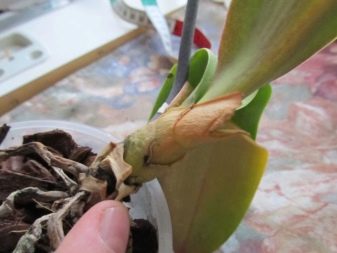

These are basic tips to help speed up the healing process of your orchid and minimize the damage that has been done to your orchid in the past. Strict adherence to the recommendations and advice will give a chance not only to save the affected bush, but also to prevent any deviations in development thanks to the rich knowledge in this area.
For information on how to reanimate an orchid, see the next video.































The comment was sent successfully.